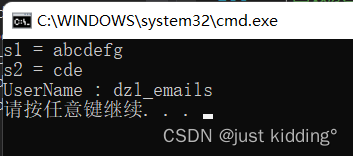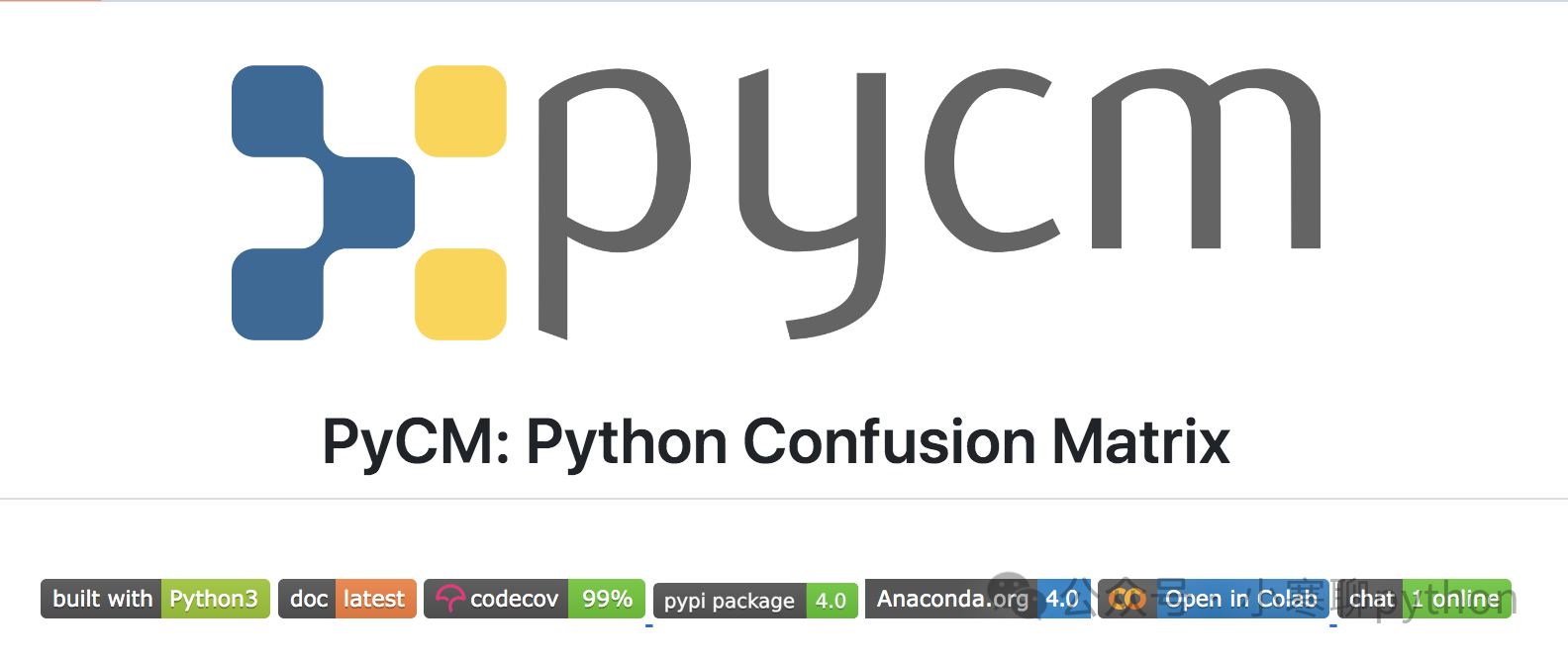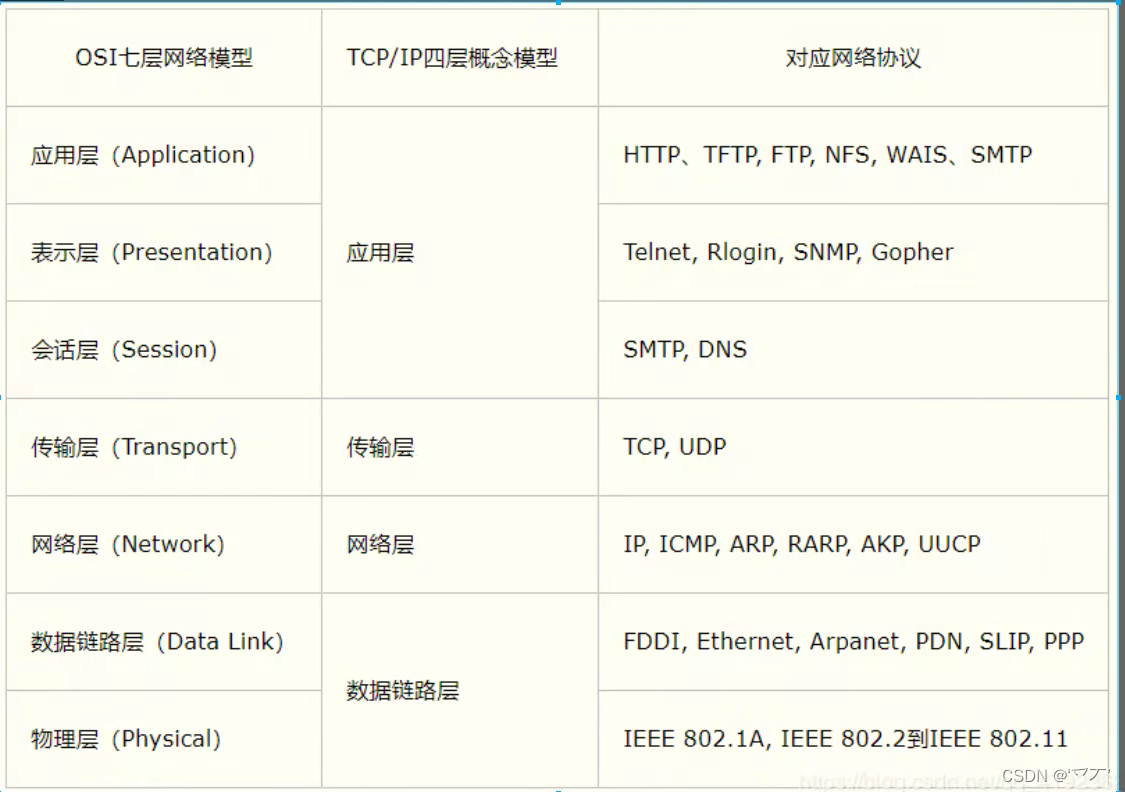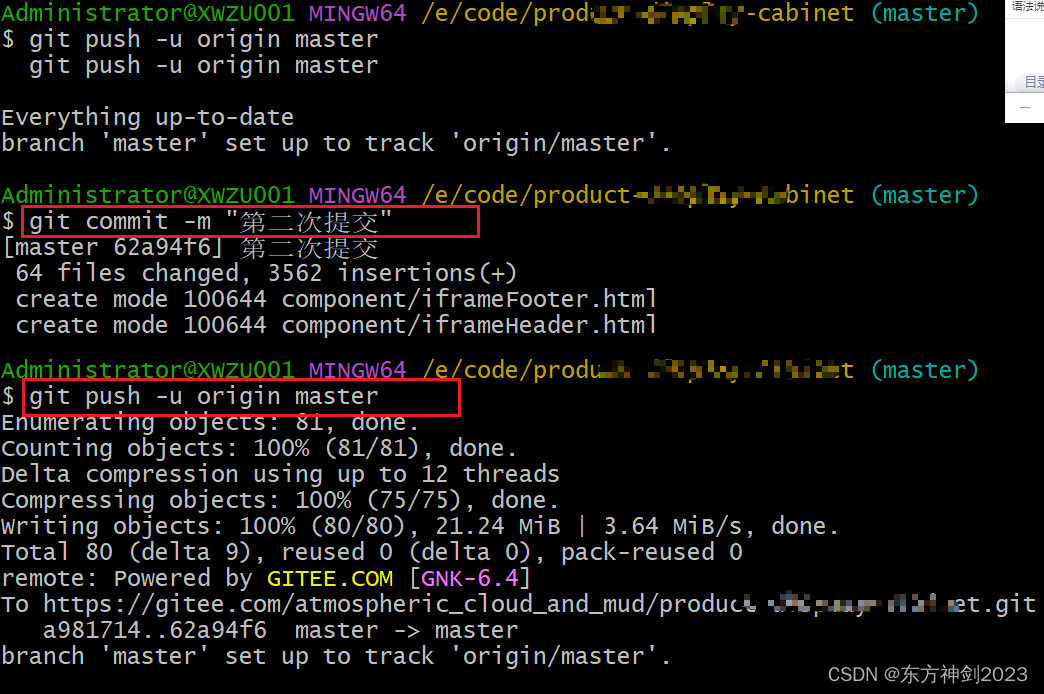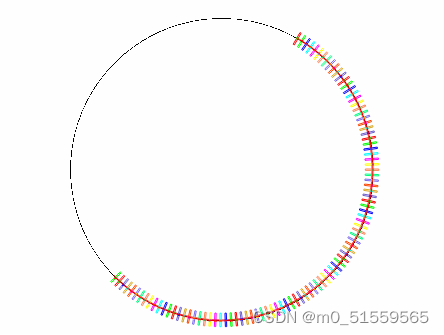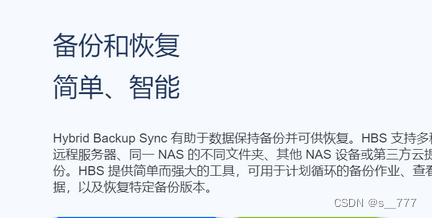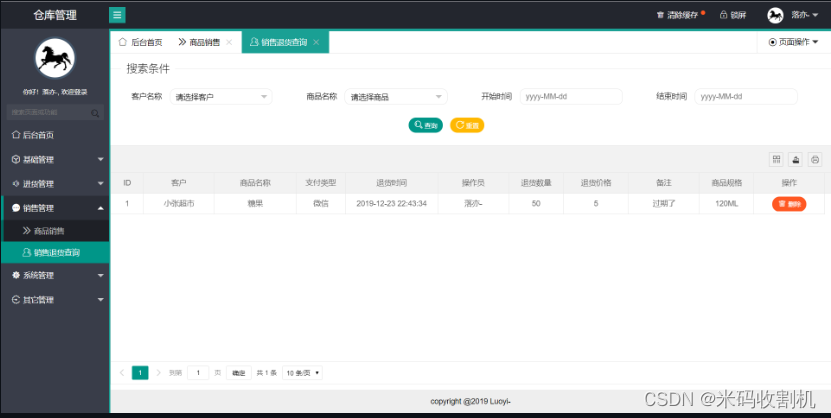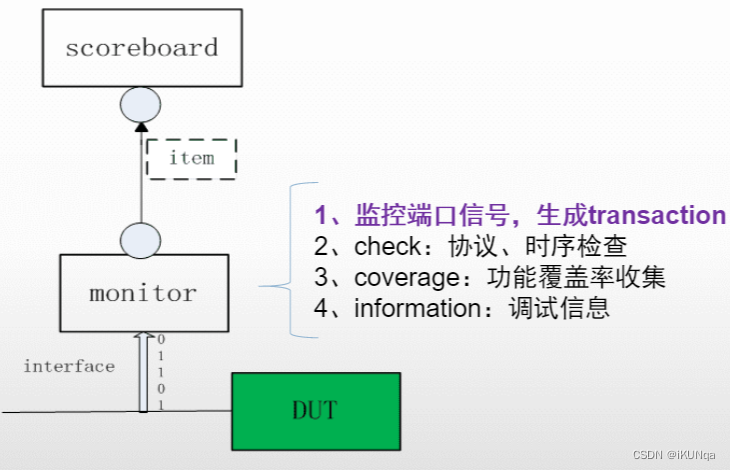一、string基本概念
1、本质
string是C++风格的字符串,而string本质上是一个类
string和char * 区别:
char * 是一个指针
string是一个类,类内部封装了char*,管理这个字符串,是一个char*型的容器。
2、特点
1、string 类内部封装了很多成员方法
(例如:查找find,拷贝copy,删除delete 替换replace,插入insert)
2、string管理char*所分配的内存,不用担心复制越界和取值越界等,由类内部进行负责
3、string构造函数
① string构造函数原型:
string(); // 创建一个空的字符串 例如:string str;
string(const char * s); // 使用字符串s初始化
string(const string & str); // 使用一个string对象初始化另一个string对象
string(int n,char c); //使用n个字符c初始化
② string的多种构造方式没有可比性,灵活使用即可。
例子
#include <iostream>
using namespace std;
#include<string>
//string的构造函数
/*
构造函数原型:
string(); //创建一个空的字符串 例如: string str;
string(const char* s); //使用字符串s初始化
string(const string& str); //使用一个string对象初始化另一个string对象
string(int n, char c); //使用n个字符c初始化
*/
void stringtest01()
{
string s1; //默认构造 就是空字符串
const char *str = "lalalala";
string s2(str); //使用字符串 s 初始化
string s3(s2);
string s4(5, 'a');
cout << "s2 = " << s2 << endl;
cout << "s3 = " << s3 << endl;
cout << "s4 = " << s4 << endl;
}
int main()
{
stringtest01();
system("pause");
return 0;
}
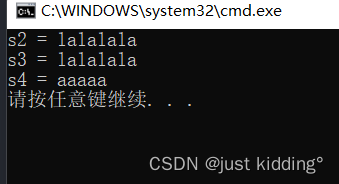
2.3 string赋值操作
① 给string字符串进行赋值。
② 赋值的函数原型:
赋值的函数原型:
string& operator=(const char* s); //char*类型字符串 赋值给当前的字符串
string& operator=(const string &s); //把字符串s赋给当前的字符串
string& operator=(char c); //字符赋值给当前的字符串
string& assign(const char *s); //把字符串s赋给当前的字符串
string& assign(const char *s, int n); //把字符串s的前n个字符赋给当前的字符串
string& assign(const string &s); //把字符串s赋给当前字符串
string& assign(int n, char c); //用n个字符c赋给当前字符串
③ string的赋值方式很多,operator=这种方式是比较常用的。
例子
void stringtest02()
{
string s1 = "cgslbdfapofclaujbrank!";
cout << "s1 = " << s1 << endl;
string s2;
s2 = s1; //把字符串s赋给当前的字符串
cout << "s2 = " << s2 << endl;
string s3;
s3 = 'a'; //字符赋值给当前的字符串
cout << "s3 = " << s3 << endl;
string s4;
s4.assign("vvvvvvvv");
cout << "s4 = " << s4 << endl;
string s5;
s5.assign("abcdefghijklmn", 5);
cout << "s5 = " << s5 << endl;
string s6;
s6.assign(s5);
cout << "s6 = " << s6 << endl;
string s7;
s7.assign(9, 'a');
cout << "s7 = " << s7 << endl;
}
int main()
{
stringtest02();
system("pause");
return 0;
}
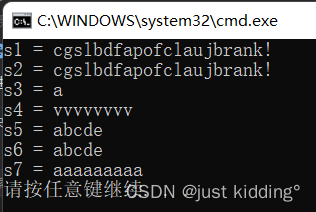
2.4 string字符串拼接— 实现在字符串末尾拼接字符串
① 实现在字符串末尾拼接字符串。
② 函数原型:
字符串拼接函数原型:
string& operator+=(const char* str); //重载+=操作符
string& operator+=(const char c); //重载+=操作符
string& operator+=(const string& str); //重载+=操作符
string& append(const char *s); //把字符串s连接到当前字符串结尾
string& append(const char *s, int n); //把字符串s的前n个字符连接到当前字符串结尾
string& append(const string &s); //同operator+=(const string& str)
string& append(const string &s, int pos, int n); //字符串s中从pos开始的n个字符连接到字符串结尾
例子
void stringtest03()
{
string s1 = "I";
s1 += "abcd";
cout << "s1 = " << s1 << endl;
s1 += ':';
cout << "s1 = " << s1 << endl;
string s2 = "LKMN";
s1 += s2;
cout << "s1 = " << s1 << endl;
s1.append("qwer");
cout << "s1 = " << s1 << endl;
s1.append("ty:uiop", 3);
cout << "s1 = " << s1 << endl;
s1.append(s2);
cout << "s1 = " << s1 << endl;
s1.append(s2, 1, 3);// 从下标1位置开始 ,截取3个字符,拼接到字符串末尾
cout << "s1 = " << s1 << endl;
}
int main()
{
stringtest03();
system("pause");
return 0;
}
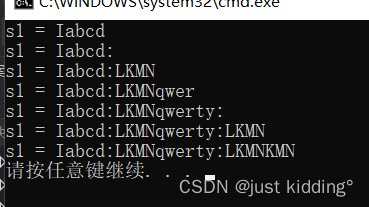
2.5 string字符串查找和替换
① 查找:查找指定字符串是否存在。
② 替换:在指定的位置替换字符串。
③ 函数原型:
函数原型:
int find(const string& str, int pos = 0) const; //查找str第一次出现位置,从pos开始查找
int find(const char* s, int pos = 0) const; //查找s第一次出现位置,从pos开始查找
int find(const char* s, int pos, int n) const; //从pos位置查找s的前n个字符第一次位置
int find(const char c, int pos = 0) const; //查找字符c第一次出现位置
int rfind(const string& str, int pos = npos) const; //查找str最后一次位置,从pos开始查找
int rfind(const char* s, int pos = npos) const; //查找s最后一次出现位置,从pos开始查找
int rfind(const char* s, int pos, int n) const; //从pos查找s的前n个字符最后一次位置
int rfind(const char c, int pos = 0) const; //查找字符c最后一次出现位置
string& replace(int pos, int n, const string& str); //替换从pos开始n个字符为字符串str
string& replace(int pos, int n,const char* s); //替换从pos开始的n个字符为字符串s
④ find查找是从左往右,rfind从右往左。
⑤ find找到字符串后返回查找的第一个字符位置,找不到返回-1。
⑥ replace在替换时,要知道从哪个位置起,多少个字符,替换成什么样的字符串。
例子
void stringtest04()
{
string s1 = "abcdefabcimnlkabcmnrsabcqrst";
int pos = (int)s1.find("bc");
cout << "找到字符串,位置POS : " << pos << endl;
pos = (int)s1.rfind("bc");
cout << "找到字符串,位置POS : " << pos << endl;
s1.replace(1, 3, "1111"); //从1号位置起后面4个字符替换为 1111
cout << "S1 = " << s1 << endl;
}
int main()
{
stringtest04();
system("pause");
return 0;
}
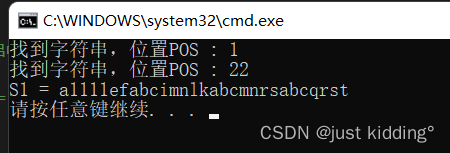
2.6 string字符串比较
① 功能描述:字符串之间比较。
② 比较方式:字符串比较是按字符的ASCII码进行对比。
比较方式:
字符串比较是按字符的ASCII码进行对比
= 返回 0
> 返回 1
< 返回 -1
③ 函数原型:
函数原型:
int compare(const string &s) const; //与字符串s比较
int compare(const char *s) const; //与字符串s比较
例子
void stringtest05()
{
string s1 = "abcdefg";
string s2;
s2.assign(s1);
string s3 = "sddfghh";
cout << "s1 : " << s1 << endl;
cout << "s2 : " << s2 << endl;
cout << "s3 : " << s3 << endl;
int ret = s1.compare(s2);
cout << "S1 & S2 比较结果 : " << ret << endl;
ret = s1.compare(s3);
cout << "S1 & S3 比较结果 : " << ret << endl;
}
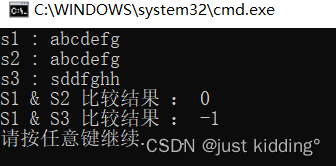
2.7 string字符串存取
① string中单个字符存取方式有两种:
string中单个字符存取方式有两种
char& operator[](int n); //通过[]方式取字符
char& at(int n); //通过at方法获取字符
例子
void stringtest06()
{
string s1 = "abcdefg";
cout << "s1 = " << s1 << endl;
for (int i = 0; i < s1.size(); i++)
{
cout << s1[i] << " " << endl;
}
char c = s1.at(3);//通过at方法获取字符
cout << "第3个字符为: " <<c << endl;
//通过上述两种方式修改字符串值
s1[0] = 'x';
cout << "s1 = " << s1 << endl;
s1.at(3) = 'x';
cout << "s1 = " << s1 << endl;
}

2.8 string字符串插入和删除
① 功能描述:对string字符串进行插入和删除字符操作。
② 函数原型:
函数原型:
string& insert(int pos, const char* s); //插入字符串
string& insert(int pos, const string& str); //插入字符串
string& insert(int pos, int n, char c); //在指定位置插入n个字符c
string& erase(int pos, int n = npos); //删除从Pos开始的n个字符
*/
③ 插入和删除的起始下标都是从0开始。
例子
void stringtest07()
{
string s1 = "abcdefg";
cout << "s1 = " << s1 << endl;
s1.insert(2, "WWW");
cout << "s1 = " << s1 << endl;
s1.erase(2, 3);
cout << "s1 = " << s1 << endl;
}

2.9 string子串获取
① 功能描述:从字符串中获取想要的子串。
② 函数原型:
函数原型:
string substr(int pos = 0, int n = npos) const; //返回由pos开始的n个字符组成的字符串
*/
③ 灵活的运用求子串功能,可以在实际开发中获取有效的信息。
例子
void stringtest08()
{
string s1 = "abcdefg";
cout << "s1 = " << s1 << endl;
string s2 = s1.substr(2, 3);
cout << "s2 = " << s2 << endl;
//截取邮箱名字
string email = "dzl_emails@163.com";
int pos = (int)email.find('@'); //找到 @ 符号位置
string UserName = email.substr(0, pos); //从位置0到pos位置间,就是邮箱名字,可以使用子串返回
cout << "UserName : " << UserName << endl;
}
